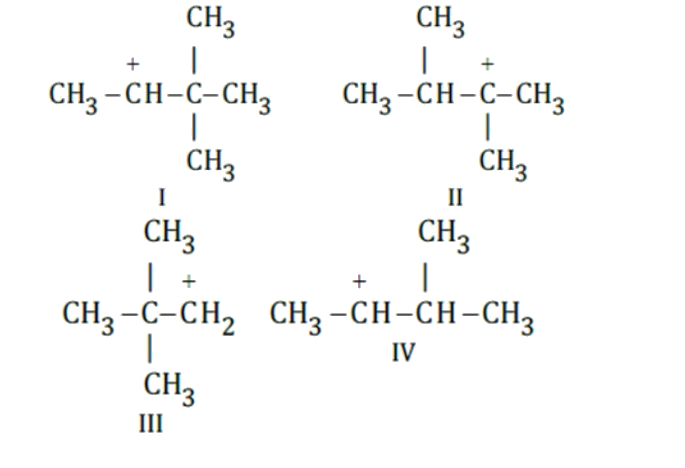Which of the following carbocations is expected to be most stable?




The correct Answer is:C
To determine which carbocation is expected to be the most stable, we need to analyze the effects of substituents on the carbocation stability, particularly focusing on resonance effects and the influence of electron-withdrawing groups like the nitro group (NO2).
1. Understanding Carbocation Stability:
- Carbocation stability is influenced by the ability of surrounding groups to donate or withdraw electron density.
- Electron-donating groups (EDGs) stabilize carbocations through resonance (positive mesomeric effect, +M) while electron-withdrawing groups (EWGs) destabilize them through resonance (negative mesomeric effect, -M).
2. Identifying the Carbocations:
- We have four carbocations to analyze, each with a nitro group (NO2) attached in different positions relative to the positive charge.
3. Analyzing Each Carbocation:
- Carbocation 1: The NO2 group is directly attached to the carbon with the positive charge. The -M effect of NO2 will destabilize this carbocation significantly.
- Carbocation 2: The NO2 group is adjacent to the positive charge, allowing some resonance stabilization but still exerting a -M effect, making it less stable than carbocations with no -M effects.
- Carbocation 3: The NO2 group is positioned such that it does not participate in resonance with the positive charge. Therefore, there is no -M effect acting on this carbocation, making it more stable than the previous two.
- Carbocation 4: The NO2 group is again directly conjugated with the positive charge, exerting a strong -M effect, which destabilizes this carbocation.
4. Comparing Stability:
- Carbocation 3 is the most stable because it does not have the destabilizing -M effect from the NO2 group acting on it. The other carbocations are either destabilized by the -M effect or have less effective resonance stabilization.
5. Conclusion:
- The most stable carbocation among the given options is Carbocation 3.
- Carbocation stability is influenced by the ability of surrounding groups to donate or withdraw electron density.
- Electron-donating groups (EDGs) stabilize carbocations through resonance (positive mesomeric effect, +M) while electron-withdrawing groups (EWGs) destabilize them through resonance (negative mesomeric effect, -M).
- We have four carbocations to analyze, each with a nitro group (NO2) attached in different positions relative to the positive charge.
- Carbocation 1: The NO2 group is directly attached to the carbon with the positive charge. The -M effect of NO2 will destabilize this carbocation significantly.
- Carbocation 2: The NO2 group is adjacent to the positive charge, allowing some resonance stabilization but still exerting a -M effect, making it less stable than carbocations with no -M effects.
- Carbocation 3: The NO2 group is positioned such that it does not participate in resonance with the positive charge. Therefore, there is no -M effect acting on this carbocation, making it more stable than the previous two.
- Carbocation 4: The NO2 group is again directly conjugated with the positive charge, exerting a strong -M effect, which destabilizes this carbocation.
- Carbocation 3 is the most stable because it does not have the destabilizing -M effect from the NO2 group acting on it. The other carbocations are either destabilized by the -M effect or have less effective resonance stabilization.
- The most stable carbocation among the given options is Carbocation 3.
Topper's Solved these Questions
- ORGANIC CHEMISTRY : SOME BASIC PRINCIPLES AND TECHNIQUES Book:ICSEChapter:ORGANIC CHEMISTRY : SOME BASIC PRINCIPLES AND TECHNIQUES Exercise:TRUE OR FALSE TYPE QUESTIONS
Explore 50 Videos
- ORGANIC CHEMISTRY : SOME BASIC PRINCIPLES AND TECHNIQUES Book:ICSEChapter:ORGANIC CHEMISTRY : SOME BASIC PRINCIPLES AND TECHNIQUES Exercise:FILL IN THE BLANK TYPE QUESTIONS
Explore 46 Videos
- ORGANIC CHEMISTRY : SOME BASIC PRINCIPLES AND TECHNIQUES Book:ICSEChapter:ORGANIC CHEMISTRY : SOME BASIC PRINCIPLES AND TECHNIQUES Exercise:ESSAY ( LONG ANSWER ) TYPE QUESTIONS
Explore 42 Videos
- HYDROGENBook:ICSEChapter:HYDROGENExercise:NCERT TEXT-BOOK EXERCISE (With Hints and Solutions)
Explore 53 Videos
- REDOX REACTIONS (OXIDATION AND REDUCTION)Book:ICSEChapter:REDOX REACTIONS (OXIDATION AND REDUCTION)Exercise:NCERT TEXT-BOOK. EXERCISES ((With Hints and Solutions)
Explore 69 Videos
Similar Questions
Knowledge Check
Which of the following carbanion expected to be most stable?
Ap−NO2C^H4−CH2Bo−NO2C6H4−CH2Co−CHOC6H4CH2Dp−CHOC6H4CH2Which of the following two carbocation is more stable ?
 AA−II,B−IIBA-I, B-ICA-I, B-IIDA-II, B-I
AA−II,B−IIBA-I, B-ICA-I, B-IIDA-II, B-IWhich of the following carbanions is most stable?
ACH3−өCH2BCH2=CH−өCH2CCH3−O∣∣C−өCH2DCH3−NH∣∣C−өCH2
Which of the following carbocations is most stable ?

View SolutionWhich of the following carbocations is most stable ?
View SolutionWhich of the following carbocation is most stable?
View SolutionWhich one of the following carbocation is most stable ?
View SolutionWhich of the following compounds is expected to be the most ionic?
View Solution